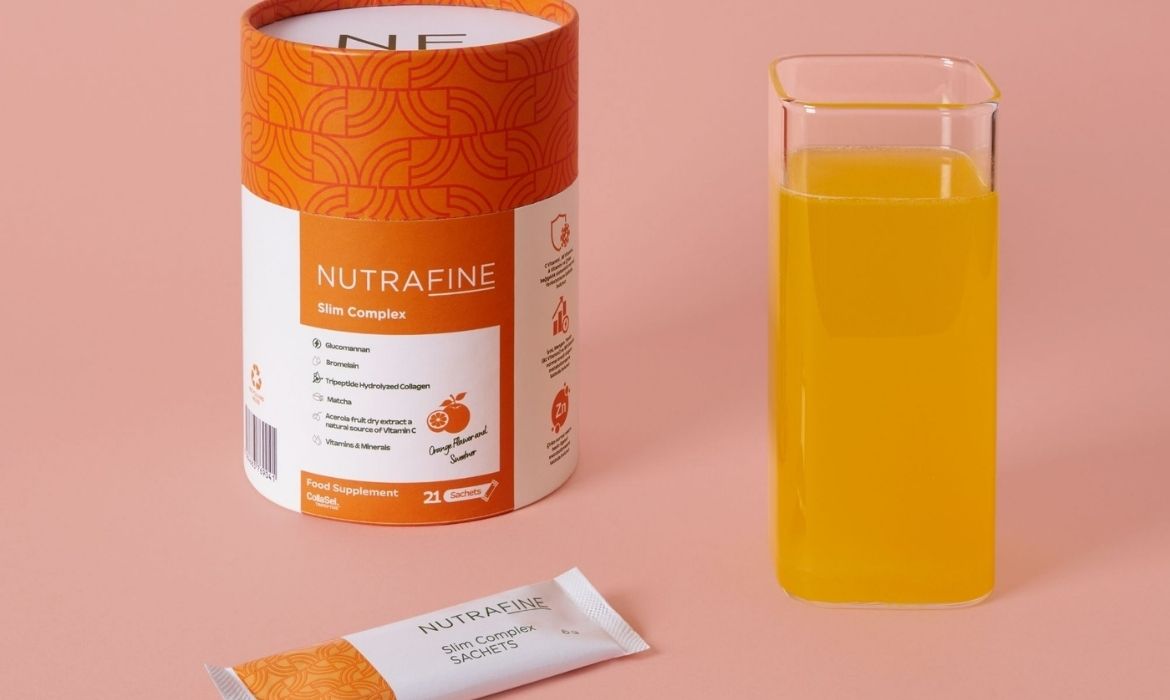Nutrafine Slim Complex
-

- Dyt. Özge Bezirci
- 26 September 2025
Konjac Glucomannan
Konjac glucomannan (or simply “glucomannan”) is a type of water-soluble dietary fiber obtained from the root of the Amorphophallus konjac plant. It has been scientifically studied particularly in relation to weight management, gut health, and blood sugar regulation.
Glucomannan is a soluble polysaccharide with high water-absorbing capacity, derived from Amorphophallus konjac. Its main structure consists of mannose and glucose molecules linked by β-1,4 bonds.
Fiber content:
Contains approximately 40–60% dietary fiber. When in contact with water, it can expand up to 50–100 times its volume.
Health Effects
-
Weight Management
-
Mechanism: Delays gastric emptying, increases satiety, and may reduce energy intake.
-
Studies: A meta-analysis (Keithley & Swanson, 2005) showed that glucomannan, when used with a low-calorie diet, results in modest weight loss. The EFSA (European Food Safety Authority) confirmed that daily intake of 3 g glucomannan, combined with a low-calorie diet, can contribute to weight reduction (EFSA Journal, 2010; 8(10):1798).
-
-
Blood Sugar Control
-
Mechanism: Slows carbohydrate absorption, reducing postprandial glucose spikes.
-
Studies: Some studies show glucomannan consumption lowered HbA1c and fasting glucose in type 2 diabetes patients (Vuksan et al., Diabetes Care, 1999).
-
-
Cholesterol-Lowering Effect
-
Mechanism: Binds bile acids, reducing cholesterol absorption.
-
Studies: A meta-analysis by Anderson et al. (2008) reported that glucomannan can reduce total cholesterol by 10% and LDL by 7%.
-
-
Gut Health
-
Acts as a prebiotic, positively influencing gut microbiota.
-
Increases stool bulk and may help relieve constipation.
-
Dosage: Typically 3 g/day with plenty of water.
Side effects: Mild digestive issues such as gas, bloating, diarrhea, or cramps.
Warnings: Without sufficient water, it may cause obstruction in the throat or esophagus. Tablet formulations have been restricted in some countries for this reason.
Collagen Tripeptide
Collagen tripeptide is obtained by enzymatic hydrolysis of fish, pork, or bovine collagen. It consists of short peptide chains of three amino acids, most commonly Gly–Pro–Hyp (glycine–proline–hydroxyproline).
-
Molecular Weight: ~300–500 Daltons.
-
Thanks to its low molecular weight, it is absorbed efficiently from the intestine, enters the bloodstream, and reaches target tissues.
Health Effects
-
Skin Health & Anti-Aging
-
Stimulates fibroblasts to produce new collagen, elastin, and hyaluronic acid.
-
Antioxidant properties may reduce UV damage.
-
Studies:
-
Inoue et al. (2016): Women who took 3 g collagen tripeptide daily for 8 weeks had improved skin hydration, elasticity, and dermal collagen density.
-
Proksch et al. (2014): Hydrolyzed collagen peptides, especially tripeptide form, improved skin elasticity and reduced wrinkles.
-
-
-
Joint & Bone Health
-
Stimulates chondrocytes, supporting cartilage matrix.
-
Reduces inflammatory markers, alleviating joint pain.
-
Studies:
-
Iwai et al. (2005): 90% of orally ingested collagen tripeptides were absorbed into the blood within 6 hours, with some reaching joint tissues.
-
Supplementation showed improvements in osteoarthritis symptoms.
-
-
-
Muscle & Sports Performance
-
Limited direct effect on muscle mass, but supports tendons and ligaments, reducing injury risk.
-
May aid post-exercise recovery (Zdzieblik et al., 2015).
-
Dosage: Typically 2.5–5 g/day.
Safety: Generally well tolerated. Possible allergy risk from fish or bovine sources.
Bromelain
Bromelain is a proteolytic enzyme complex extracted from the stem (especially the core) or fruit of the pineapple (Ananas comosus). It is plant-derived and known for anti-inflammatory, anti-edematous, digestive, and immunomodulatory properties.
Composition & Mechanism:
Contains mainly proteases, as well as other enzymes and non-protein compounds.
-
Breaks proteins into amino acids → aids digestion.
-
Affects the kallikrein-kinin system → reduces edema & inflammation.
-
Regulates prostaglandin synthesis → reduces pain & inflammation.
-
Has fibrinolytic activity → supports circulation, regulates clotting.
-
Modulates cytokines → immune-regulating effect.
Clinical Uses
-
Anti-Inflammatory & Anti-Edema
-
Used for sports injuries, post-surgical swelling, sinusitis, arthritis.
-
Sources: Maurer HR (2001); Bhattacharyya BK (2008).
-
-
Digestive Support
-
Aids protein digestion, may help in exocrine pancreatic insufficiency.
-
-
Sinusitis & Respiratory Infections
-
Acts as mucolytic and anti-inflammatory.
-
Source: Braun et al. (2005).
-
-
Osteoarthritis & Rheumatic Disorders
-
May reduce pain and stiffness, similar to NSAIDs.
-
Source: Walker et al. (2002).
-
-
Immune Support & Cancer Research
-
Shown to have immunomodulatory and anti-tumor potential in preclinical studies (not yet standard clinical use).
-
Dosage: 160–1000 mg/day (varies by formulation).
-
With food → supports digestion.
-
On empty stomach → systemic anti-inflammatory effects.
Side effects: Generally safe. May cause nausea, diarrhea, allergic reactions (pineapple allergy), blood-thinning effect (caution with anticoagulants).
Chromium-Enriched Yeast
Chromium-enriched yeast is produced by growing Saccharomyces cerevisiae under special conditions so that it incorporates chromium into biologically active forms.
Role of Chromium in the Body:
-
Enhances insulin action, regulates glucose uptake into cells.
-
Involved in carbohydrate, fat, and protein metabolism.
-
Believed to be part of the “Glucose Tolerance Factor” (GTF).
Dosage: Typically 200–400 mcg/day.
-
Trivalent chromium (Cr³⁺) is safe.
-
Hexavalent chromium (Cr⁶⁺) is toxic and not used in supplements.
Regulatory status: Recognized as safe (GRAS) by the FDA.
Side effects: Rare, may include mild stomach upset or headache.
Acerola Fruit Extract
Known for its exceptionally high vitamin C content. Scientifically studied for immune support, antioxidant activity, and skin health.
Nutrient Content (per 100 g fresh fruit):
-
Vitamin C: 1000–2500 mg (30–50 times higher than orange)
-
Other compounds: Polyphenols (anthocyanins, flavonoids), carotenoids (beta-carotene), vitamins B2 & B3, potassium, magnesium.
Benefits
-
Immune Support: Vitamin C enhances immune cell activity and proliferation.
-
Antioxidant Effect: Polyphenols + vitamin C = strong free radical scavenging.
-
Skin Health & Collagen Synthesis: Vitamin C is a cofactor for collagen production; acerola improves elasticity and reduces aging signs.
-
Iron Absorption: Boosts non-heme iron absorption, helping prevent anemia.
Dosage: Typically 500–1000 mg acerola extract (≈100–200 mg natural vitamin C).
Safety: Well tolerated. High doses may cause mild digestive discomfort or laxative effects. Rare allergy risk in sensitive individuals.
Matcha
A special Japanese green tea. Unlike other green teas, it is shade-grown, briefly steamed, dried, and ground into fine powder using stone mills.
Benefits
-
Focus & Calm: Caffeine + L-theanine → sustained alertness with calmness.
-
Rich in EGCG: 3–10× more than regular green tea.
-
Antioxidant Protection: Reduces oxidative stress (Unno et al., 2015).
-
Weight Management: Catechins boost thermogenesis and fat oxidation (Hursel & Westerterp-Plantenga, 2010).
-
Relaxation: L-theanine increases alpha brain waves, balancing caffeine’s effects (Nobre et al., 2008).
Dosage: 1–2 g/day (≈1–2 teaspoons).
Side effects: Possible palpitations or insomnia in caffeine-sensitive individuals, stomach irritation if taken on an empty stomach. Choose high-quality products free of heavy metals.
Zinc Citrate
A supplemental form of zinc, with good absorption and tolerability.
Benefits
-
Immune Support: Helps defend against infections. Supplementation shortens duration of colds (Prasad et al., 2007).
-
Skin & Hair Health: Supports acne treatment, skin barrier, and hair cycle.
-
Wound Healing: Essential for fibroblast proliferation and epithelial repair.
-
Antioxidant Protection: Component of SOD (superoxide dismutase).
Advantages: High absorption, gentle on stomach, useful in plant-based diets (reduces phytate effect).
Excess intake: Can cause nausea, diarrhea, reduced copper absorption, immune suppression at very high doses.
Manganese Sulfate
Uses
-
Nutritional Supplement: Corrects manganese deficiency. Considered safe by EFSA & FDA.
-
RDA: Men 2.3 mg, Women 1.8 mg. Supplements usually provide 1–5 mg.
-
-
Agriculture: Corrects manganese deficiency in alkaline soils.
-
Animal Feed: Supports bone growth, reproduction, and metabolism.
-
Industry: Used in ceramics, glass, batteries (esp. LiMn₂O₄ cathodes).
Functions: Antioxidant defense, energy metabolism, bone development. Safe when used within limits; toxic at high doses.
Retinyl Acetate
A stable vitamin A ester that converts to retinol after ingestion. Retinol is further converted to retinal (vision) or retinoic acid (cell growth and differentiation).
Functions: Eye health, immunity, cell growth, skin health. Common in supplements and cosmetics due to stability.
Excess intake risks: Liver toxicity, teratogenicity in pregnancy, headache, nausea, dry skin.
Source: Institute of Medicine (US) - Dietary Reference Intakes, 2001.
Copper Citrate
A supplemental form of copper with good absorption and tolerability compared to inorganic salts.
Copper Deficiency Symptoms: Anemia (like iron deficiency), hair loss, immune weakness, neurological issues, osteoporosis.
At risk groups: Malabsorption (e.g., celiac, Crohn’s), gastric bypass patients, those on high-dose zinc.
Functions: Supports iron metabolism, immunity, antioxidant defense, nervous system.
Excess intake: Can be toxic with long-term high doses. Should be used under medical guidance.
Cholecalciferol (Vitamin D₃)
-
Produced in skin from 7-dehydrocholesterol via UVB light (290–315 nm).
-
Found in foods (salmon, egg yolk, liver) and supplements.
Roles
-
Bone & Calcium Metabolism: Enhances calcium & phosphorus absorption, regulates parathyroid hormone. Deficiency → rickets, osteomalacia, osteoporosis (Holick, 2007).
-
Immune Support: Modulates T & B cells, boosts antimicrobial peptides (Martineau et al., 2017).
-
Neurological & Metabolic Health: Impacts oxidative stress, inflammation, cognition, diabetes, and depression (Annweiler et al., 2010).
Forms: Drops, capsules, tablets, injections. Use under medical advice.
Pyridoxine Hydrochloride (Vitamin B6)
A water-soluble form of vitamin B6, commonly used in supplements.
-
Converted to active coenzymes PLP & PMP in the body.
Benefits:
-
Nervous System: Key for neurotransmitter synthesis (serotonin, dopamine, GABA). Deficiency → depression, irritability, neuropathy.
-
Heart Health: Along with B12 & folate, lowers homocysteine levels.
-
Protein Metabolism: Involved in amino acid metabolism.
-
Pregnancy: Used (with doxylamine) for nausea (FDA-approved).
Excess: >100 mg/day may cause neuropathy (numbness, tingling).
Thiamine Hydrochloride (Vitamin B1)
A stable, water-soluble B1 form.
Deficiency Risks: Chronic alcoholism, poor diets, malabsorption, dialysis.
Functions: Energy metabolism, nerve signaling, heart health, cognition.
Safety: Non-toxic, excess excreted in urine. Rare allergic reactions with injections.
Potassium Iodide (KI)
A key iodine source for supplements and medicine.
Functions:
-
Iodine is essential for thyroid hormone (T3, T4) production → regulates metabolism, growth, brain development.
-
Prevents goiter from iodine deficiency. Added to salt worldwide.
Special Use:
-
Protects thyroid from radioactive iodine (I-131) during nuclear accidents (FDA, 2001).
-
Also used in hyperthyroidism (short-term), as a mucolytic, and rarely as antifungal.


 NL
NL
 ENG
ENG
 DE
DE